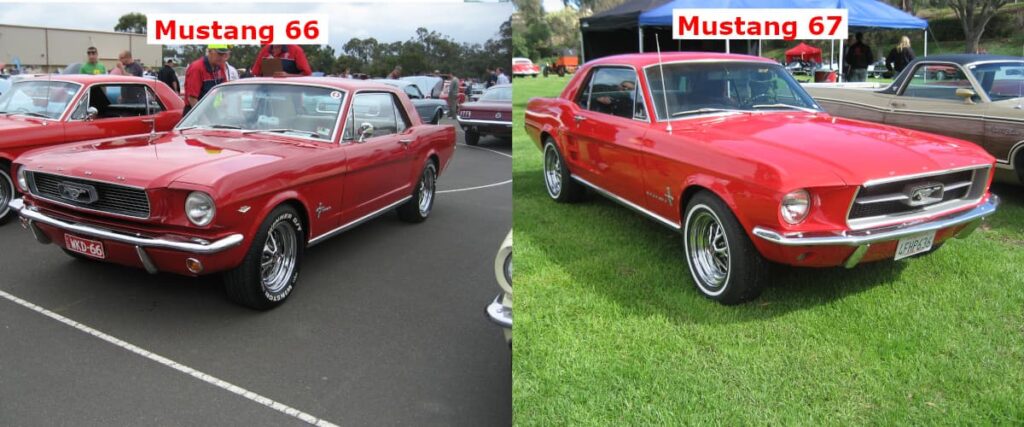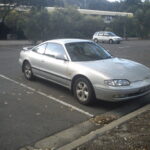Mustang 66 vs. 67 – Differences Explained!
Without a doubt, Ford Mustang was the first car ever to start the muscle car era in the U.S and its debut was so hit among the public that nearly 2 million were sold in less than a week. The real torch-bearer of Pony cars, Mustang started a new fashion that still lives to this day, and is admired by millions.
Ford was launched in 1964 and was quickly given cosmetic and performance upgrades over the next few years. Although the initial few years were fairly similar, the noticeable differences in the Mustang generations appeared when the 66 model year was updated in 67, and a visually distinct car was birthed. Let’s go through some of the important differences between the 66 Mustang vs 67, and how you can distinguish one from the other.
What are the Specs of 66 Mustang and 67 Mustang?
As both the model years were based on the same platform and used almost the same powertrain, they enjoyed the same specs on paper. Apart from a few cosmetic differences and interior options, the majority of the other specifications were the same.
Both 66 and 67 Mustang were 2-door coupes, popularly known as pony cars. Featuring a range of 6-cylinder and V8 engines, power was never short with the Mustang owners. Producing up to 320 horsepower and 290 lb-ft of torque, Mustang 66 and 67 were among the few initial cars to test 0-100 timing.
Paired to the series of powerful engines were both manual and automatic transmissions and rear-wheel drive ultimate performance. Interior was almost like, except for a few comfort options that were added to 67 Mustang for a better driving experience.
Also read: 10 Best 300 HP Cars for Less Than $20k
What are the Differences Between Exterior Styling?
If you see two Mustangs standing side by side, the 66 Mustang, popularly known as 64.5, and the 67 Mustang, you’d easily be able to tell the difference between the two. There are a few distinct differences in exterior styling that set both the model years apart. Let’s understand what those are;

Quarter Panel Ornamentation
While designing the exterior of the 1966 Mustang, Ford added a new quarter panel ornamentation to the side which had 3 horizontal sweeps and was finished in chrome. This design replaced the single deep side scoop which debuted with the car itself.
The 1967 Mustang had its quarter panel ornamentation redesigned again. The three sweeps that were previously trimmed in chrome were replaced by twin air scoops and painted in the same color as the car’s exterior. 67 Mustang is the only model from the initial years when the pony car had twin air scoops.
Grille
The grille on the 1966 Mustang featured a panel of horizontal bars with a Corralled Mustang logo in front. It was a unique and revised design, an all-new language as compared to the previous model.
When the 1967 Mustang arrived, it went back 2 years and took inspiration from the 65 models, featuring a wall of horizontal and vertical bars surrounding the pony logo. The pony was located in front of a black horizontal grill, with the GT version having the same grille.
Rear Panel
Another recognizable difference in the exterior design of the 66 and 67 Mustang is the rear end. The 66 Mustang featured a convex rear panel with convex taillights enclosed in a chrome ring.
The 67 Mustang had exactly the opposite of it and had a concave rear panel with similarly concave designed taillights. Both these vehicles could be judged immediately once looked at from the rear side.
Gas Cap
Ford has always played with the fuel cap design to make things interesting, ever since the Mustang has been in production. In the 1966 Ford Mustang, the designers made small ridges on the cap top, and for the 1967 model, they mixed the 65 and 66 both, sculpting three blades with ridged design for the gas cap.
Dimensions Differences
| Dimension | 66 Mustang | 67 Mustang |
| Length | 181.6 inches | 183.6 inches |
| Height | 51.1 inches | 51.6 inches |
| Width | 68.2 inches | 70.9 inches |
| Wheelbase | 108 inches | 108 inches |
| Weight | 2,640 lbs | 2,723 lbs |
What are the Major Updates in the Interior of the 1967 Mustang?
Despite being a newer model, the 67 Mustang shared a lot with the 66 in terms of interior. They had similar interior space, including head and knee room, and almost similar kinds of bucket seats and cockpit layout.
The major change was the instrument cluster, which instead of 3, had 5 gauges for more information and was easier to read due to its larger size.
There were many comfort and luxury features in the 1967 model, that were missing in the 66 Mustang and were then considered an industry new. These include;
- A newly designed tachometer
- A trip odometer
- A Convenience Panel, that included the parking brake, low fuel indication, seatbelt alert, and lights for door ajar.
- Cruise control (then called Fingertip Speed Control)
- A retractable steering column
Also read: 8 Cars that Look Like Mustangs (But are Cheaper)
What are the Mechanical Differences Between 66 and 67 Mustang?
In the powertrain department, there were not many differences between the two and you could really tell what was under the hood of the two cars. As the technology was yet infantile, pony cars were still relying on 3-speed auto and V8s for power.
Engine
Both the 1966 and 1967 models were offered with 2.7L, 3.3L, and 6.7L options with 6 or 8-cylinder configurations. Although the powertrains were nearly identical and the owners of both model years could enjoy the high-performance V8, the 1967 Mustang got a unique Big Block V8 engine as an option.
It was super powerful and could propel the pony car from nothing to 100 in just 7.3 seconds. Apart from this big block V8, all other engine options were the same for both years.
Transmission
The transmission options were also identical for both model years and comprised either a 3-speed or 4-speed manual, or even a Cruise-O-Matic transmission.
The only difference was that the 67 Ford Mustang did not come with the 3-speed manual option with the base engine.
Automatic transmission was launched just a few years later.
Were Both 1966 and 1967 Mustangs Available with GT Options?
Yes! you could get either of the 66 or 67 Mustangs with the GT option. Customers could only upgrade to a GT package if they also selected the upgraded V8. Although Ford’s large options list allowed for the purchase of the majority of the GT’s features individually as well, however, the base i-6 and the initial V8 engines were not available for the performance package upgrade.
When you purchased the GT upgrade in the 1966 Mustang, you also received upgraded suspension parts, disc brakes on the front wheels, and racing stripes in addition to the twin exhaust system with chrome-wrapped tips. Additionally, they would add the letters “GT” in lieu of the Mustang on your fuel cap.
Fog lamps were offered as standard equipment for GT Mustangs, and came fitted into the bumpers from the factory. For the 1967 Mustang, if you opted for GT and had the top V8 engine, you would also get chrome-plated quad exhaust extensions.






